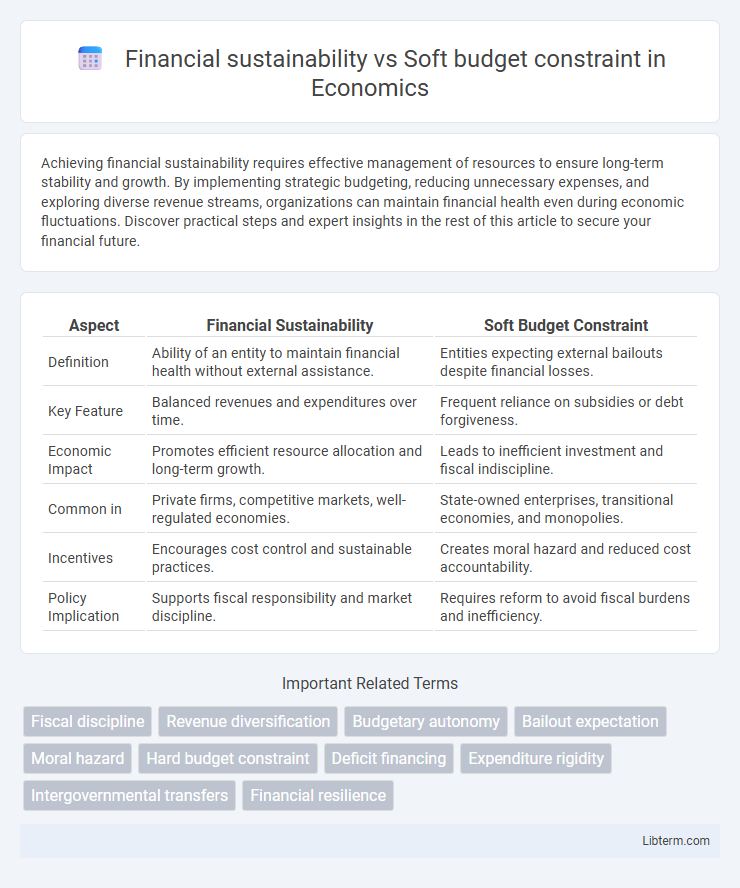Achieving financial sustainability requires effective management of resources to ensure long-term stability and growth. By implementing strategic budgeting, reducing unnecessary expenses, and exploring diverse revenue streams, organizations can maintain financial health even during economic fluctuations. Discover practical steps and expert insights in the rest of this article to secure your financial future.
Table of Comparison
| Aspect | Financial Sustainability | Soft Budget Constraint |
|---|---|---|
| Definition | Ability of an entity to maintain financial health without external assistance. | Entities expecting external bailouts despite financial losses. |
| Key Feature | Balanced revenues and expenditures over time. | Frequent reliance on subsidies or debt forgiveness. |
| Economic Impact | Promotes efficient resource allocation and long-term growth. | Leads to inefficient investment and fiscal indiscipline. |
| Common in | Private firms, competitive markets, well-regulated economies. | State-owned enterprises, transitional economies, and monopolies. |
| Incentives | Encourages cost control and sustainable practices. | Creates moral hazard and reduced cost accountability. |
| Policy Implication | Supports fiscal responsibility and market discipline. | Requires reform to avoid fiscal burdens and inefficiency. |
Understanding Financial Sustainability: Key Principles
Financial sustainability emphasizes maintaining a balance between revenues and expenditures to ensure long-term operational viability without relying on external bailouts. Soft budget constraints occur when organizations expect external financial support despite deficits, undermining incentives for efficient resource management. Understanding key principles such as accountability, cost control, and realistic budgeting is essential for fostering financial discipline and resisting soft budget dependency.
The Concept of Soft Budget Constraint Explained
The concept of soft budget constraint refers to the tendency of organizations or governments to exceed budget limits due to expected external financial support when facing deficits. This phenomenon undermines financial sustainability by encouraging inefficient resource allocation and reducing incentives for fiscal discipline. Understanding soft budget constraints is crucial for implementing policies that promote responsible budgeting and long-term economic stability.
Historical Evolution of Soft Budget Constraints
The historical evolution of soft budget constraints traces back to socialist economies where enterprises were shielded from financial failure by state subsidies, undermining financial sustainability and incentivizing inefficiency. Over time, transitional economies experienced persistent soft budget constraints, reflecting governments' reluctance to enforce strict budget discipline amid political and social pressures. Modern economic reforms emphasize establishing hard budget constraints to improve financial sustainability by promoting accountability and reducing dependence on external bailouts.
Financial Sustainability in Modern Organizations
Financial sustainability in modern organizations ensures long-term viability by effectively managing resources, revenues, and expenses to avoid dependence on external bailouts. It emphasizes maintaining positive cash flows and prudent financial practices that prevent the erosion of operational autonomy often caused by soft budget constraints. Organizations prioritizing financial sustainability invest in robust budgeting, cost control, and strategic planning to secure ongoing financial health and resilience in dynamic market environments.
Causes and Consequences of Soft Budget Constraints
Soft budget constraints arise when organizations or entities expect external financial support, leading to reduced incentives for cost control and efficiency. Causes include government bailouts, political pressures, and institutionalized subsidies, which create reliance on continuous financial aid despite poor performance. Consequences involve inefficient resource allocation, fiscal indiscipline, and weakened financial sustainability, ultimately undermining long-term economic stability.
Strategies for Achieving Financial Sustainability
Achieving financial sustainability involves implementing strategies such as rigorous budgeting, efficient resource allocation, and diversifying revenue streams to reduce reliance on external funding. Organizations must establish robust financial controls and performance metrics to avoid the pitfalls of a soft budget constraint, which encourages overspending due to the expectation of bailouts. Emphasizing transparency, accountability, and long-term planning ensures continuous fiscal health and resilience against economic uncertainties.
Case Studies: Successes and Failures in Budget Discipline
Case studies on financial sustainability and soft budget constraints reveal critical lessons in budget discipline across various sectors. Successful examples, such as Singapore's government-linked companies, demonstrate strict fiscal control and accountability measures that prevent recurrent bailouts and encourage efficient resource allocation. In contrast, failures like the post-Soviet transition economies highlight how persistent soft budget constraints led to chronic inefficiencies, excessive debt accumulation, and weakened financial stability.
Policy Implications: Hard vs. Soft Budget Constraints
Hard budget constraints enforce strict financial discipline, compelling organizations or governments to balance revenues and expenditures without reliance on external bailouts, which promotes long-term financial sustainability. Soft budget constraints often lead to inefficiencies by enabling continuous financial support despite poor performance, undermining fiscal responsibility and causing resource misallocation. Policy implications favor adopting hard budget constraints to ensure accountability, enhance economic efficiency, and foster sustainable fiscal management, particularly in public sector and state-owned enterprises.
Challenges in Transitioning to Financial Sustainability
Transitioning to financial sustainability involves overcoming the challenge of breaking free from a soft budget constraint mentality, where organizations rely on continuous external bailouts rather than efficient resource management. This shift demands rigorous financial discipline, improved revenue generation, and cost-control mechanisms to reduce dependency on subsidies or government support. Failure to address these challenges can result in persistent inefficiencies, undermining long-term financial viability and organizational resilience.
Comparative Analysis: Financial Sustainability vs. Soft Budget Constraint
Financial sustainability ensures an organization's capacity to maintain operations and meet financial obligations without external assistance, emphasizing long-term efficiency and profitability. In contrast, the soft budget constraint phenomenon occurs when entities rely on continuous external bailouts, leading to inefficiencies and reduced incentives for cost control. Comparative analysis reveals that while financial sustainability promotes autonomy and resilience, soft budget constraints foster dependency and financial mismanagement.
Financial sustainability Infographic

 libterm.com
libterm.com